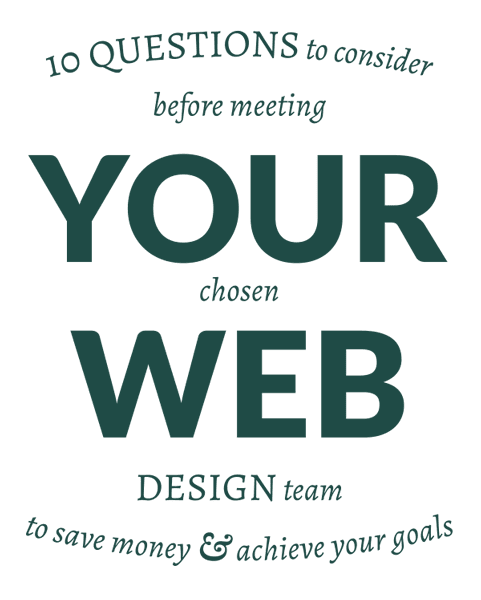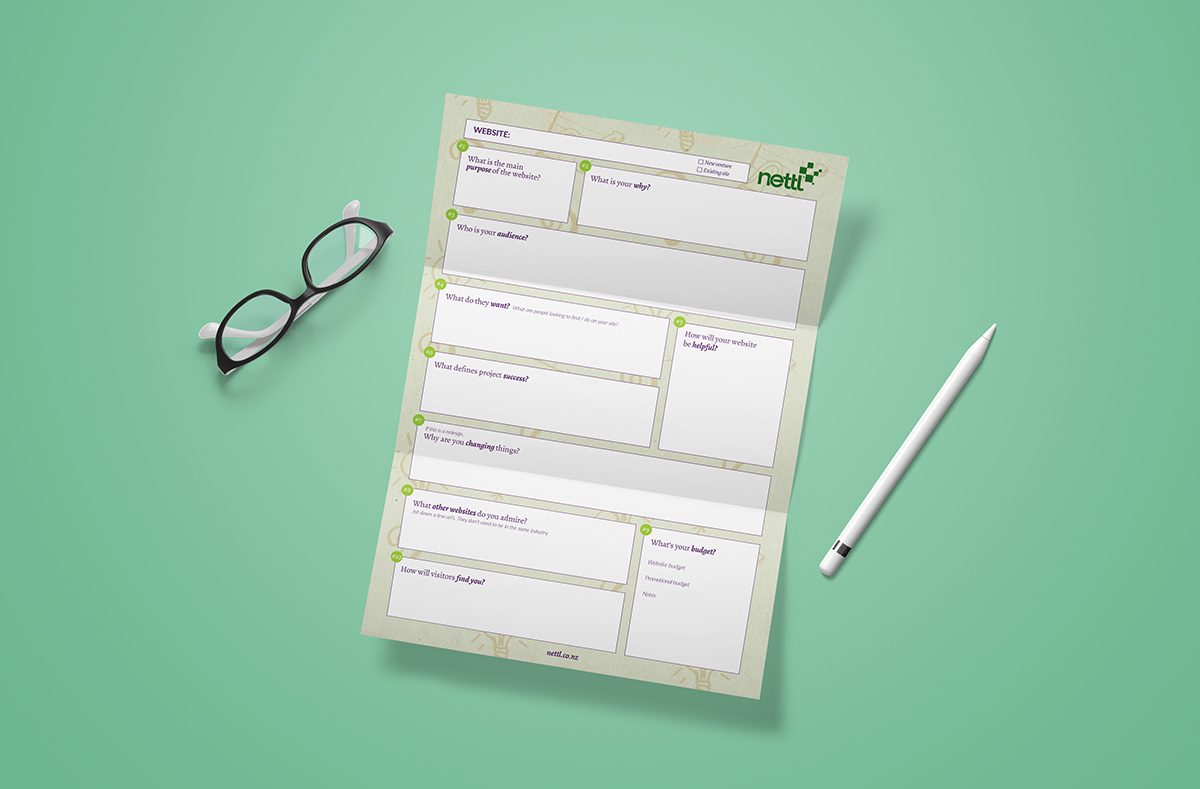10 QUESTIONS TO CONSIDER BEFORE MEETING YOUR WEB DESIGNER TO SAVE MONEY & ACHEIVE YOUR BUSINESS GOALS
approx 8 minute read
New year. New site
There’s something about the start of a new year that inspires people.
A fresh start. Renewed enthusiasm. Goals and resolutions.
That’s why so many businesses think ‘new year: new website’.
For some, the Christmas break can provide the breathing space needed to take a step back and think about the bigger picture.
So for those business owners, marketers and pioneers out there, we’ve created 10 questions for you to mull over, over a mulled wine or two. Or cinnamon tea.
Use these pointers to help you plan. It will uncover the motivations and intent behind the project, helping you and your web design team define and achieve your online success.
1: What is the main purpose of your website?
To provide information about your business, awareness and credibility or perhaps provide information about your products and services.
Often the main purpose is to sell goods. An E-commerce website is able to sell products around the clock, to take payments and ship goods.
Or maybe it’s a different kind of interaction? Maybe you need your website to take bookings or have people make appointments.
Is the website an essential part of your business?
Or is the website a place to provide information on the company, an extension of the brand (microsite), or a side project?
It might not be a business at all!
Perhaps your website is for an event, community or charity you’re looking to raise awareness about.
Whatever the reason, it’s important to have clarity on what is the one single main purpose for the website.
2: What is your website ‘why’?
This is an extension to the question above as it goes deeper into understanding the ‘why’ over the ‘what’.
Not so much ‘What do you want the website to do’ but also ‘Why do you want it to do this?’
And in doing so, your design team will be in a stronger position to make recommendations. For instance, the main purpose for your website might be to provide information about the business. And this could be in order to position yourself in the marketplace, establish credibility and trust.
Often your ‘Why’ can determine your goals for the project.
You might like to include an online sales target, a number of users, visitors, enquiries or bookings.
3: Who is your audience?
How you answer this question will very depending on whether it’s a new website or a redesign, a new business or an established one.
If your website is brand new there’ll be a bit of guessing. Educated guessing of course.
If it’s established, you’ll have data to work with and existing customers to ask.
But either way that’s just the start. Because there is a difference between knowing your audience and really understanding what type of people they are.
It isn’t enough to only know that they are certain types of businesses in certain areas. Consider the people visiting your site. What are their ages, interests, hobbies, favourite brands?
By understanding the type of people using your website, you and your design team can make more informed choices on the design and delivery of content.
More importantly, you’ll have a better understanding of what people come to your website to find or do.
Aligning user intent to your content is key for SEO and conversion rate optimisation.
4: What do your audience want?
Now you have a clear picture about who your audience is, really focus on their needs.
What are they looking to do or find or do on your website?
This helps to clarify user intent. Aligning user intent to your content is key for SEO and conversion rate optimisation.
Thinking about this will help you deliver what the audience wants more effectively.
You can design your content and navigation around it.
The clarity makes designing landing pages incredibly simple.
Don’t assume. If you have existing analytics data, we can use this, alongside surveys, to help figure this out.
If it’s a new enterprise then do some research online.
Organise a focus group, talk to potential buyers, ask on social media, or create a survey on Survey Monkey.
5: How can your website be ‘helpful’
Search engines (and actual people!) LOVE helpful content.
So think about your users. Think about the community you serve. Create the most helpful, valuable content you possibly can.
If your company installs boilers then fab… Business info, check. Boiler service booking functionality, check.
But how about we add some useful content about safety or energy advice?
Imagine you sell camping products. Super! Publish a blog, add videos, provide value for free.
Your website could thrive from adopting a helpful-content-first approach.
Provide the campfire for people to gather around.
Build a community and recommend products to an engaged audience.
6: What defines project success?
Would the project be a success if delivered on budget by a certain date?
Or do factors such as number of visitors, repeat visitors and time spent on site come into play?
Are you looking for rankings to improve? User feedback to be more positive? More active users? Your database to grow? Enquiries to double? Sales to increase?
It’s impossible to know whether the project was a success unless you set clear, measurable goals from the beginning.
These need to be numbers and dates. (So, 10% increase by month three. 25,000 subscribers in year one. That sort of thing).
We’ve thrown a few ideas at you there, and it’d be nice to have them all, right?
But it’s better to focus on one.
It makes design choices and split testing more effective to have one clearly defined objective.
7: Why are you changing things?
If you are redesigning your website, why?
Was it something your last website did to upset you?
Perhaps your current website doesn’t seem as attractive as it used to.
Or could it be that your business is into new things now? Maybe you’ve just grown apart.
Change is good. Websites change all the time.
They should constantly grow and evolve to adapt to things like user behaviour, technology, search engine algorithms and the law.
Popular reasons for change include:
- The need to make the website work better on a mobile
- The desire to sell products online
- Wanting to appear for more searches related to your business
- Making it easier to edit and add new content yourself
Discussing these points not only ensures the new website ticks the boxes but also helps us anticipate things to consider in the future.
8: What websites do you admire?
This is an efficient way to understand your website aspirations from a visual and user experience point of view.
You can take hours to write a design brief but sometimes a few example visuals with notes really gets us on the same page.
It doesn’t have to be people in the same space. Although cool if you can.
Look at your competitors. Look at the websites currently ranking well for the searches that you wish to rank for. Jot down what’s hot and what’s not.
We never want to lift website copy directly off another site. But we can emulate the good things they do.
Maybe it’s certain user needs they address well. Maybe it’s a style of navigation or call-to-action that helps guide users in a certain way.
If you’re not sure, that’s ok. Often, after a short conversation, your design team can recommend some sites that might be up your street.
Designing a new website should be a creative and satisfying project that you can really enjoy.
9: What’s your budget?
Asking how much a website costs is a little like asking how much a house costs to build.
The budget required for your unique project will depend on the options you choose along the way. So it is important to have a figure in mind that you feel comfortable investing.
And it is an investment. Because you should consider the value of your website to your business.
Some will see a website as an overhead. An expense. Please don’t. Your website is an amazing opportunity to connect with your customer and establish long term relationships.
Sometimes people are reluctant to reveal their budget. You shouldn’t be. It will actually ensure you get the best possible bang for your buck.
Often, it will be a range of prices, again dependent on the feature and design choices made along the way. So as you can imagine, there are many variables. However, to help people get a rough idea of pricing, we’ve developed an online tool.
Our instant web quote tool provides an instant ballpark figure for your next website project in 3 quick and easy steps.
Important: When evaluating budget, don’t forget to allocate a figure for hosting, ongoing maintenance, and promotion of your website.
10. How will your audience find you?
Although website design and user experience are pivotal to overall success, your offsite activity is just as influential.
For your signups to grow, your enquiries to double and your sales to increase, we need to get people there in the first place.
The only way to do that is to signpost people to your website from other sources.
People won’t drive past your website (well, unless it’s on a building, van or billboard!). A mix of online and offline marketing activity is essential to drive people TO your website.
Even if it’s the BEST WEBSITE EVER, a co-ordinated launch is needed to get the right people talking about it.
Search engines drive more traffic to websites than any other source. So SEO and Ads are a smart place to start.
You’ll need to have an up-to-date Google Business Profile. And social media gets a lot of attention of course.
But that doesn’t mean offline media should be ignored as part of the mix.
We’ve created a pdf that you can download for free!
You can complete it in acrobat, print it off and fill it in, or just use it as a guide.





